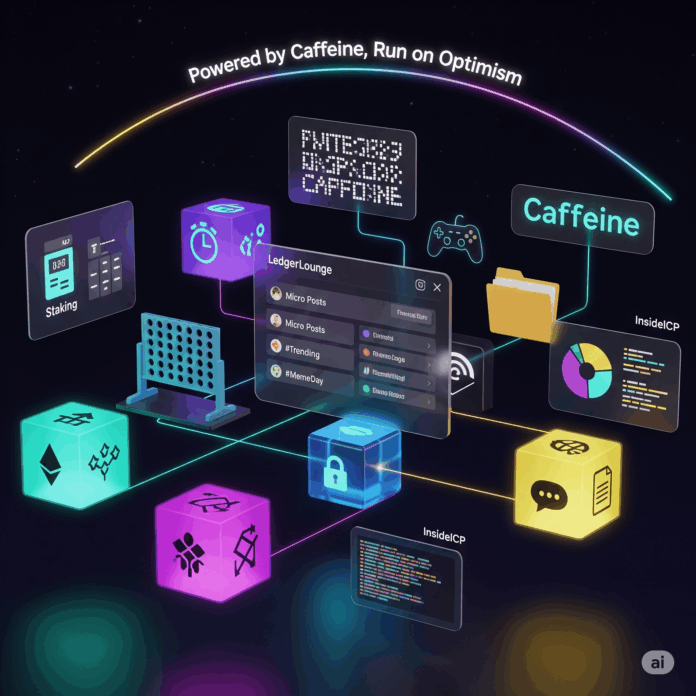Day 7 of Caffeine AI’s open testing phase produced a remarkable batch of early-stage apps, reflecting what happens when independent developers are handed ready‑made tools and asked simply to create. The offerings range from staking calculators and time trackers to social feeds, games and file storage—all built in a public, experimental environment. The results may be rough around the edges, but they speak to a growing movement of real prototypes arriving fast on Internet Computer.
The process powering it all is refreshingly straightforward. An invite code appears in your inbox, you log into Caffeine, and you start building. The barrier between idea and deployment is gone. It might not be easy to polish every interface, optimise every interaction or fix every bug, but it does mean that real code emerges quickly, and usage insights come in almost overnight. It’s where friction gets removed, and you end up with a cadence of one new project per day.
One of the more practical releases came from @HAMpng, who launched an ICP staking calculator. It’s a simple tool, admittedly, but one that many users have been asking for. By pulling real neuron data, it estimates staking rewards precisely. No generic projections, no placeholder numbers—just actual data moulded into a calculator. That kind of niche utility matters for anyone managing tokens and staking strategies.
Here is our’s LedgerLounge is shaping up fast. From a barebones prototype to a functional micro-posting space in just days, the platform is evolving with every session. The basic posting interface is live, profile setup is clean, and image upload is almost there. We’ve integrated wallet display (waiting on full activation from the Caffeine team), sorted the site’s tagline and identity, and are now building out admin tools, hashtag filters and content categories like Trending, Builder Rants and Meme Day. It’s still rough, still raw—but already oddly addictive to build. Every bug and friction point feels like a prompt for the next improvement.
What makes LedgerLounge exciting isn’t polish—it’s pace. This is what building in public looks like: we post a feature, spot what’s missing, tweak the config, and push the next version. We’re keeping the feed open, the updates transparent, and the ethos light. Think “powered by caffeine, run on optimism.” The longer play includes engagement tracking, a rewards loop, and NFT tie-ins, but right now it’s all about proving momentum. A good post, a clean log-in, a shared link that works—each small win feels like real movement. LedgerLounge may be LedgerLife’s wildcard sibling, but it’s becoming a space where ICP ideas can breathe out loud.
Meanwhile, @novahodler released a mobile‑first time‑tracking app, aimed at work hours and pay calculation. It’s no small task to build a reliable time tracker with precise mobile UI. But the result is a polished tool that could easily serve small teams or freelancers. The fact it’s already functioning suggests Caffeine can support workflows that many thought would be far too complex to throw together in a day.
A highlight from a returning voice was from Eerik Potter. After a month away, he’s back with reflections on his journey and a new project. He described how Caffeine helped him test what he termed a paradigm shift in developer tooling. Although he found that updating larger code bases took several minutes, he praised the broader trajectory. He’s building what he calls a sovereign “cloud” and wiki‑style knowledge base app, focused on multi‑canister storage and user ownership. His project aims to offer a multi‑lingual, self‑hosting storage and education tool running on Internet Computer. Renewal, experimentation and longevity are running side by side here.
Games were part of the mix, too. @JustinJackBear dropped his Fatoshi’s First Run, a playful 2D game doubling as an interactive captcha. It includes token rewards—$ICP $CLOUD $BTC—encouraging users to collect and engage. Visitors love that the experience feels light and immediate. The simplicity and token‑driven reward makes it fun, and it’s the kind of thing you might expect from a token‑powered social feed.
Security and file storage merits get a look as well. @cryptodicted launched IC‑files, building a private‑by‑default file uploader and manager that you can share securely through unique links. Built with React and Tailwind on the ICP stack, it feels familiar to web developers but with added blockchain security. A splash of dark‑mode makes it stylish too. This is an early MVP, but it already serves a clear need.
Over in the social space, @accumulatingicp is teasing observers with their work on $MOTOKO Social public launch. No flashy names, but the promise of a wallet‑native social platform is enough to get attention as more people chase identity‑driven social feeds.
Meanwhile, @ICP_insider called Caffeine AI “a beast.” He launched InsideICP, a dashboard showing cycle burn, dApp trends, ecosystem tools and a form to submit projects. Designed as a hub for the broader ICP world, it’s the kind of meta‑tool that suggests maturity in this early experimental wave—something that helps developers keep track of everything else being built.
Another project from Marlon Hank caught our eye: The Code Manager, a sandbox for budding developers. It allows non‑devs to paste in code, lock it down, and later share it with a developer for review or deployment. It’s a clever nod towards community‑driven development and education, letting people experiment without needing to launch full dApps.
A recurring theme across these apps is their founder’s hunger for experimentation. None of them are finished products, but they all solve real problems or explore new interactions. They might show bugs, rough UIs or missing features—but that very visibility fuels feedback loops and iteration.
Some projects already spark ideas for future expansions. The staking calculator, for instance, could evolve into a full portfolio dashboard. LedgerLounge could morph into a social hub for micro‑blogs on blockchain. Time tracker could integrate payments or gig management. IC‑files could layer in access controls, encryption or drag‑and‑drop uploads. Sovereign cloud could spawn privatized document collaboration. Everything displayed in Day 7 could shift into version 2 by day 10—open testing breeds fast change.
Yet the initiative isn’t without its limits. As Eerik pointed out, performance slows down with larger apps. Token integration still has friction. Debugging is human‑driven, not automated. Many of these tools rely on entering code by hand and managing tokens via scripts. For now, the more complex the app, the more patience is required.
That said, every developer who publicly delivered something on Day 7 proves a point: AI‑supported environments can remove traditional friction. You don’t need to wait months for deployment or review; a broken MVP can ship today. Even better, you learn what works, what doesn’t, and how people use it—all in short cycles.
There’s also a broader lesson about software roles. Building remains a team effort even with AI help. From Marlon’s Code Manager to Eerik’s return to architecture‑led building, the message is clear: AI assists, it doesn’t replace. Developers still solve logic problems, think about design, and steer product direction. Every one of the Day 7 participants had to think beyond code—they thought about usage, utility, or ideals.
As we move past Day 7, it’s worth asking where this wave leads. Will some of these tools find sustainable usage? Could any of them be integrated into larger apps or protocols? Might developers learn from one another and collaborate across projects? For now, it’s too early to say. But the first lit signs are there: usability, clarity, token incentives that make sense and interactive code that invites exploration.
What matters is that the builds are public. It’s not a closed beta behind corporate walls. We see code, usage paths and logs. We read dev reflections, coupling personal thought with public accountability. That feeds trust, iteration and community cohesion.
Day 7 might not host fully polished flagship apps, but it hosts genuine motion. That movement matters more than hype. Developers are exploring directly, testing token rewards, linking web UI to on‑chain processes, and learning by doing. Each of these first drafts is a seed.
If Caffeine AI can refine performance, token support and deployment pipelines, this iteration‑first model could become a standard for web3 dev. But even as things stand, the pace is promising. When developers just build, the creative output tells the future’s story.
Dear Reader,
Ledger Life is an independent platform dedicated to covering the Internet Computer (ICP) ecosystem and beyond. We focus on real stories, builder updates, project launches, and the quiet innovations that often get missed.
We’re not backed by sponsors. We rely on readers like you.
If you find value in what we publish—whether it’s deep dives into dApps, explainers on decentralised tech, or just keeping track of what’s moving in Web3—please consider making a donation. It helps us cover costs, stay consistent, and remain truly independent.
Your support goes a long way.
🧠 ICP Principal: ins6i-d53ug-zxmgh-qvum3-r3pvl-ufcvu-bdyon-ovzdy-d26k3-lgq2v-3qe
🧾 ICP Address: f8deb966878f8b83204b251d5d799e0345ea72b8e62e8cf9da8d8830e1b3b05f
🪙 BTC Wallet: bc1pp5kuez9r2atdmrp4jmu6fxersny4uhnaxyrxau4dg7365je8sy2q9zff6p
Every contribution helps keep the lights on, the stories flowing, and the crypto clutter out.
Thank you for reading, sharing, and being part of this experiment in decentralised media.
—Team Ledger Life


